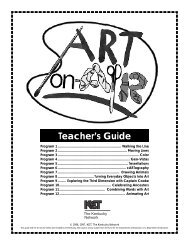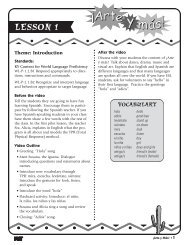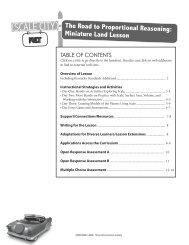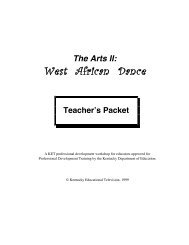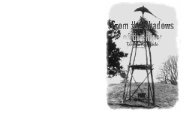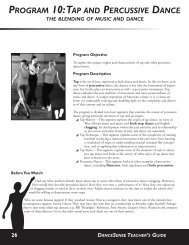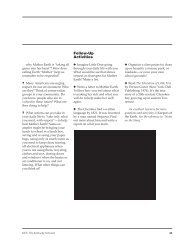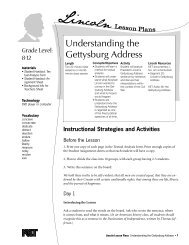7369 old music 2402 - KET
7369 old music 2402 - KET
7369 old music 2402 - KET
You also want an ePaper? Increase the reach of your titles
YUMPU automatically turns print PDFs into web optimized ePapers that Google loves.
The Old Music<br />
Instruments<br />
Following are brief descriptions of<br />
the instruments featured in Old Music<br />
for New Ears. Some instruments appear<br />
in more than one program. Each<br />
chapter in this guide begins with a list<br />
of the instruments in that program so<br />
that you can refer back to this section<br />
for background information.<br />
Talking about how these instruments<br />
led to the development of today’s<br />
popular instruments helps demonstrate<br />
to children that modes of creative<br />
expression evolve as different groups<br />
of people migrate and mingle, sharing<br />
their traditions and producing new<br />
“hybrids.”<br />
autoharp<br />
A German invention which became<br />
popular among Southern rural people in<br />
the early 20th century, this stringed box<br />
instrument descends from the same<br />
family as the dulcimer. Invented by<br />
C.A. Gutter in 1865, the autoharp was<br />
factory-made by the mid-1880s in New<br />
York, and nearly 3,000 were s<strong>old</strong><br />
weekly by door-to-door salesmen and<br />
sales catalogs.<br />
Around 1910 the autoharp came into<br />
popular use at social gatherings, by<br />
traveling preachers, and as therapy by<br />
hospital workers. Ernest Stoneman<br />
made the first recording with the<br />
instrument in 1924 and developed a<br />
style of short strokes and strict rhythm.<br />
In the mid-1900s, Maybelle Carter (of<br />
the famous Carter Family singing<br />
group) further changed the style of<br />
playing by h<strong>old</strong>ing the instrument<br />
vertically against her chest and plucking<br />
the strings across the middle.<br />
Program 14<br />
banjo<br />
The banjo is a plucked lute with a<br />
long guitar-like neck and a circular<br />
soundtable of tightly stretched parchment<br />
or skin (now usually plastic). The<br />
development of the five-string banjo<br />
began in the early 19th century as a<br />
largely commercial adaptation of a<br />
West African instrument, the gourd<br />
banjo, which was brought to America<br />
by slaves brought from Africa in the<br />
17th and 18th centuries. This instrument,<br />
a gourd with a skin head and a<br />
long stick with four strings attached,<br />
was played exclusively by African-<br />
Americans until the early 1800s.<br />
Immediately before and after the<br />
Civil War, thousands of escaped and<br />
freed slaves flooded the Appalachians,<br />
drawn by the isolation and lack of<br />
wealthy landowners. After 1879, the<br />
banjo as we know it became increasingly<br />
used in the United States as a<br />
parlor instrument for performing<br />
popular <strong>music</strong>. In the 1920s, the tenor<br />
banjo became more popular among<br />
urban <strong>music</strong>ians. The five-string banjo<br />
regained popularity after World War II<br />
when Pete Seeger recorded traditional<br />
rural styles and Earl Scruggs developed<br />
the “bluegrass” style of banjo playing.<br />
The banjo ukulele, a development<br />
on the fringe of the Hawaiian <strong>music</strong> fad<br />
in the 1920s, is played with ukulele<br />
fingering.<br />
Programs 2, 3, 5, 7, 9, 13, 14, 15<br />
bodhran<br />
Also known as a tambourine, this is<br />
the single-headed frame drum of<br />
Ireland. The drum is made by nailing a<br />
membrane, often of goat or deer skin,<br />
to a circular frame. Jingles are sometimes<br />
set into the frame. A criss-cross<br />
system of cord, sticks, or wire stretched<br />
over the open end of the drum serves as<br />
a handle. The bodhran is played either<br />
by hand or with a stick.<br />
Program 9<br />
bones<br />
Two pencil-length, curved bones are<br />
held in one hand so that various waving<br />
motions produce a variety of rhythms.<br />
Bones have an ancient history, reaching<br />
as far back as 3000 B.C. They were<br />
played in China, Egypt, ancient Greece<br />
and Rome, and medieval Europe. In the<br />
United States, bones are associated<br />
primarily with African-American<br />
traditions and the minstrel show.<br />
Programs 9, 16<br />
dulcimer<br />
The Appalachian, lap, or mountain<br />
dulcimer evolved on this continent and<br />
is a truly American instrument. It<br />
<strong>KET</strong>, The Kentucky Network 59



